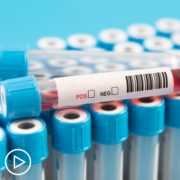How Are Myeloma Patients in Remission Monitored?
How Are Myeloma Patients in Remission Monitored? from Patient Empowerment Network on Vimeo.
How often should testing be administered when myeloma is in remission? Dr. Brandon Blue discusses how patients in remission are monitored and when a bone marrow biopsy may be required.
Dr. Brandon Blue is Assistant Member and Clinical Instructor in the Department of Malignant Hematology at Moffitt Cancer Center in Tampa, FL. Learn more about Dr. Brandon Blue.
Related Programs:

|

Should You Push for a Stronger Myeloma Treatment at Relapse? |

Questions and Considerations When Making Myeloma Treatment Decisions |
Transcript:
Katherine Banwell:
Dr. Blue, how often should bone marrow biopsy be performed in the years following a stem cell transplant?
Dr. Brandon Blue:
So, typically following stem cell transplant patients are kind of switched to what we call maintenance therapy.
Meaning that the disease is typically under control after transplant, and our job right now is to kind of put the lid on the disease and keep that lid on so that the disease doesn’t kind of bubble over. And likely, people are on that maintenance therapy for three, four, sometimes even five years, or more. And so, sometimes when the disease is very stagnant or very stable, and people are on maintenance therapy, there may not be a need for multiple repeated bone marrow biopsies.
Because the disease may just be in a kind of dormant or remission stage. However, at the first sign that we see that things are changing, we see that unfortunately the disease may be starting to relapse, or maybe even there’s a new pain, or things happening that just need further investigation, I think a bone marrow biopsy would be very warranted at that time.
Katherine Banwell:
Okay. So, when patients are in a kind of remission stage you just monitor them. Do you continue to do bloodwork, and test their urine, and so on?
Dr. Brandon Blue:
Blood, urine, imaging. Blood, urine imaging.
Katherine Banwell:
Yeah. Blood, urine, imaging.
Dr. Brandon Blue:
Yup. Those would be the best ways to follow it. Of course, the gold standard would be a bone marrow biopsy, but typically what happens is that the blood, the urine, and the imaging typically reflect what’s happening in the bone marrow. It’d be sometimes very unlikely for a patient’s bloodwork to be normal, but then the bone marrow to be ridden with cancer. Typically, it doesn’t work that way. There are some unique circumstances where bone marrow biopsies are needed in people who have something called non-secretory myeloma, but that’s a very small percentage.










